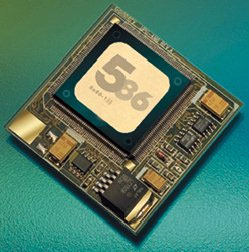|
Why Do Upgrade Proccesors exist:
Really the answer is quite simple, if you look back in time a
bit. In the early 90's when computer technology just started to
grow at a rate where it was impossible to keep up with things
were much more expensive. A Motherboard would set you back $200-$300
and a CPU about the same. Intel invariable introduced new form
factors (sockets) leaving people with the old style to have no
option but to replace that costly motherboard they had JUST bought.
Intel quickly saw the need for a stop gap solution and introduced
the 'Overdrive' processor family. Overdrives would plug in to
an old style socket and deliver a level of performance close to
that of the newest thing on the block.
This in itself was not a new concept, Cyrix had been making 486
type CPU's that worked in 386 motherboards for sometime. Other
companies eventually joined the foray such as Kingston, PNY, Gainbury
etc. Chip names such as 'Turbochip,' 'Maximizer,' and 'Powerleap'reflected
the nature of the chip.
Intel even made upgrade kits for the 286.
What is in an upgrade
CPU?
Intel's Overdrive series was based on a standard CPU, with additional
voltage regulators, for example, a 3.3V 486 CPU would be built
with regulators to work on the old style 5 Volt socket. Intels
chips also included a heatsink, and later on a fan that was powered
from the chip itself. This prevented the user from having to deal
with power plugs for the fan, a simple yet very helpful feature.
| Other companies worked in much the same way, though they
rarely used Intel CPU's. One of the most common upgrade CPUs
for the 486 was the AMD DX5-133 (aka PR75SSA among other names)
which really was just an enhanced high speed 486. These were
often built in a QFP package and soldered to a socket adapter
with the needed multiplier and voltage regulator circuits.
Other chips used the very powerful and capable Cyrix 5x86
CPU which was in reality a stripped 6x86 (Pentium class CPU).
Since these CPUs ran at higher then normal voltages, and used
extensive power regulators, they almost always had fans, some
ran off the adapter its self, while others used various plugs
to tap into drive connectors. |
 |
The introduction of the Pentium in Socket 5/7 systems made another
market in upgrading Socket 4 Pentiums (though short lived). One
of the biggest booms in upgrade processors came when Intel switched
from Socket 5/7 to the Slot 1 connector. Intel made Overdrive
processors up to 200MHz MMX for the old platform but nothing more.
Super 7 motherboards allowed people to use up to 550MHz CPUs from
AMD and 350MHz ones from Cyrix. However, people with older Socket
5/7 motherboards that didn't support these new chips (mostly boards
that didnt support the split core/IO voltages required by new
chips) were stuck at a max of 200MHz with Intels chips.
The upgrade CPU market jumped in with both feet, offering dozens
of different ways people could upgrade. The majority were based
on the Winchip series of processors (up to 300MHz) or the AMD
K6-2 line of CPU's. Again, it was only a matter of creating the
right voltages and multipliers for these CPU's.
Upgrades of Today:
Today few people still use Socket 7 systems. There are still a
large amount of people who use Slot 1 systems. Upgrades to these
systems are fairly straightforward. Slot 1 and the Socket 370
that replaced it are not very different electrically (the signals
are the same, its just the physical packageing). The Slocket was
born to remedy this, a Slocket, as its name suggests is a Socket
on a PCB that fits in a Slot 1, allowing the use of many standard
Socket 370 CPU's in Slot 1 boards. Several Upgrade Processor companies
offer bundles that have the Slocket, a CPU (usually a VIA C3 or
Celeron) and a fan. Most of these are rather simple, the voltages
are not very different, nor are power requirements. The biggest
thing is multipliers, most older boards only support up to a 6
or 7 multiplier, so the Slockets have circuitry that generates
higher ones.
With the introduction of the P4 and even more different sockets
CPU Upgrade companies have started to offer just adapters, such
as the PowerLeap adapter that will allow you to use a Socket 478
CPU in a older socket 423 system.
The Future:
CPU power requirements are getting to be very large and hard to
deal with. This will make the upgrade business a very tough one
to work with. It is hard to make an adpater that can handle over
60Amps and still leave room for the immense cooling of today's
CPU's. It is very likely that this will be the end of the Upgrade
Processor Industry. Already there are only a few companies left.
Upgrade Processors:
Intel
486 Overdrive Processors |
 |
Intel made three types of Overdrive CPU's for the 486
platform:
486
ODPR Overdrive
The Orignal 486 Overdrive was meant to upgrade motherboards
with the original Socket. It is a 5V compliant device
with speeds of up to 100MHz.
It requires replacement of the original CPU.
|
486 ODP Overdrive
The second 486 was the ODP. It was meant for later
motherboards with the 169 pin socket. Some lowcost
motherboards had a 486 SX soldered onto the board
but still provided an 'Overdrive Socket' that these
chips plugged into. The extra pin was used to disable
the original CPU
|
486 POD Overdrive
The last of the Intel 486 Overdrives was the PODP.
It was basically a Pentium in a 486 package. Its performance
was decent but Intel never allowed it to be made in
speeds that could compete with the actual pentiums
they were selling. |
| Sockets |
486 - 1 - 2 - 3 |
| Pins |
168 |
| Speeds |
50-100 |
| Fan? |
No |
| Core |
486DX |
|
| Sockets |
1 - 2 - 3 |
| Pins |
169 |
| Speeds |
40-100 |
| Fan? |
No |
| Core |
486DX |
|
| Sockets |
2 - 3 |
| Pins |
237 |
| Speeds |
63 & 83 |
| Fan |
Integrated |
| Core |
P54 - Pentium |
|
**These Overdrives are internally clock doubled. For example,
the ODP486SX-20 runs at 40MHz |
Intel
Pentium Overdrive Processors |
 |
Intel made three types of upgrade processors for the Pentium
line as well.
Intel PODP5V Overdrive
The Original Pentiums were avalable in a Socket 4
package at a speed of 60 or 66MHz. This overdrive
would take those platforms to a speed of up to 133MHz.
The Socket 4 platform was shortlived |
Intel PODP3V Overdrive
The 3Volt Overdrives were meant to upgrade every
Pentium P54C in the Socket 5/7 Package. They did not
require split voltage and were available in a wide
range of speeds. The speeds were rather arbitrary
on Intel's part as depending on which CPU was replaced,
the Overdrive would work at several different speed. |
Intel PODPMT Overdrive
The PODPMT is identical to the 3 Volt Overdrive but
adds full MMX support and 32k of L1 Cache (the original
had only 16k) |
| Sockets |
4 |
| Pins |
273 |
| Speeds |
120-133 |
| Fan? |
Integrated |
| Core |
P54C - Pentium |
Examples:
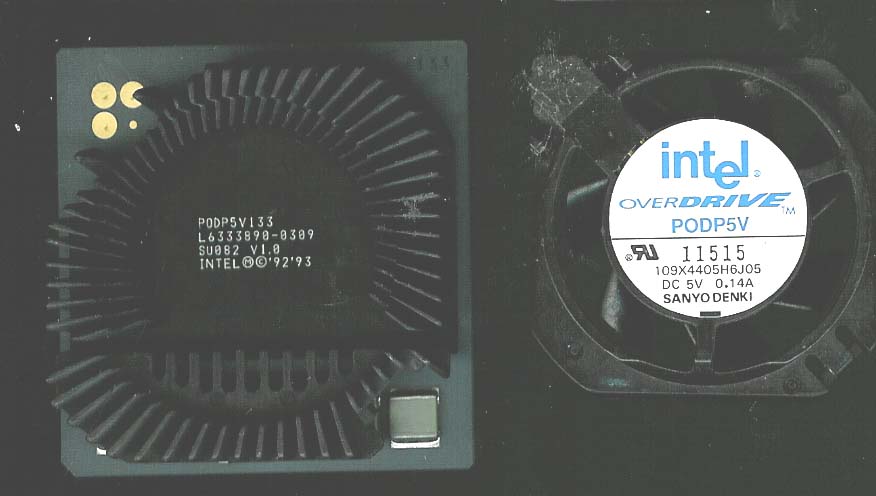
Intel
PODP5V133 V1.0
|
| Sockets |
5 - 7 |
| Pins |
320 |
| Speeds |
125-200 |
| Fan? |
Integrated |
| Core |
P54C - Pentium |
Examples

Intel
PODP3V125 V1.0
Intel PODP3V133
Intel
PODP3V150 V1.0
Intel
PODP3V166 V1.0 |
| Sockets |
5 - 7 |
| Pins |
320 |
| Speeds |
150-200 |
| Fan? |
Integrated |
| Core |
P55C - Pentium MMX |
Examples:
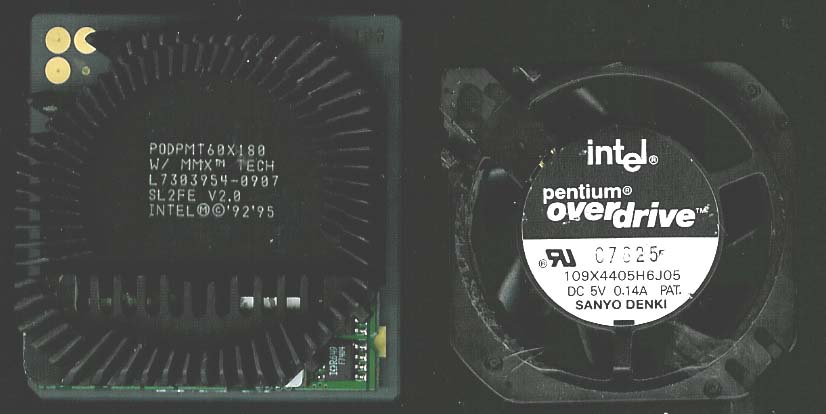
Intel PODPMT50X125^^
Intel PODPMT60X150 V1.0
Intel PODPMT66X166
Intel
PODPMT60X180 V2.0
Intel
PODPMT66X200 V2.1 |
^^There are references to this chip in Intel datasheets,
though I have never seen one. |
Intel
Pentium II Overdrive Processor |
 |
Intel PODP Pentium II Overdrive
The Pentium II Overdrive is the last Overdrive Intel
made. It can upgrade a standard Pentium Pro 150-200
to the performance of a Pentium II 300-333. The Pentium
II is nothing more then a Pentium Pro with MMX and
better 16 bit code execution so this Overdrive was
easy to make. Intel however did very little to market
it. They chose to concentrate on getting the Pentium
Pro customers to just upgrade to Pentium II or Xeon
workstations. |
| Socket |
8 |
| Pins |
387 |
| Speeds |
300-333 |
| Fan? |
Integrated |
| Core |
P2 Deschutes |
|
|
|
Kingston is most known for its memory products but they
also made many CPU Upgrade kits. They made kits for the
286 and up, but I will only detail kits for the 486 and
up.
486
TurboChip TC486/75 486TC/100
This is a lesser known Kingston made upgrade chip.
It is based upon a AMD DX4 CPU in a QFPP package.
|
486 TC5x86/133
One of the better known upgrade CPU's. It is based
on the AMD DX5-133. Basically just a high speed 486
with extra cache. It is a capable performer and happens
to be rather overclockable (160MHz is usually attainable)
|
Turbochip
TCMMX/200
The TurboChip 200 continues with Kingstons tradition
of using AMD CPUs. In this case a standard AMD K6
running at 200MHz. |
Turbochip TCMMX/233i
The MMX233i is one of the more unusual upgrade chips.
It uses an honest to goodness Intel CPU. Its performance
and market are the same as the TCMMX200 |
TurboChip
TC366-400
The TC366 and TC400 are AMD K6-2 based upgrades.
They provide the greatest speed available for old
Socket 5 systems at a relatively low cost. With these
CPU's the biggest slow down in the system is the RAM,
which is still old and slow. |
| Sockets |
486 - 1 - 2 - 3 |
| Pins |
168 |
| Speeds |
75-100 |
| Fan? |
Integrated |
| Core |
AMD DX4 |
Example:
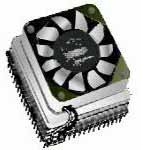
|
| Sockets |
1 - 2 - 3 |
| Pins |
169 |
| Speed |
133 |
| Fan? |
Integrated |
| Core |
AMD DX5 |
|
| Sockets |
5 - 7 |
| Pins |
320 |
| Speed |
200 |
| Fan |
Integrated |
| Core |
AMD K6 |
|
| Sockets |
5 - 7 |
| Pins |
320 |
| Speed |
233 |
| Fan |
Integrated |
| Core |
P55C |
|
| Sockets |
5 - 7 |
| Pins |
320 |
| Speeds |
366-400 |
| Fan |
Integrated |
| Core |
AMD K6-2 |
Example
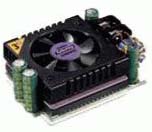
|
Evergreen Technologies
Upgrade Processors 
Evergreen has been in the CPU Upgrade business since
1989 in Corvallis Oregon. One of their selling points
has been in offering BIOS upgrades with their CPU's
to ensure compatibility.
586
One of the better known upgrade CPU's. It is based
on the AMD DX5-133. Basically just a high speed
486 with extra cache. It is a capable performer
and happens to be rather overclockable (160MHz
is usually attainable)
|
MXPro
The MXPro is a series of Upgrade chips made
by Evergreen. They use either a Winchip or a
Winchip2 as their base processor (allowing for
3D Now in the Winchip2) Their performance is
good for office apps, but horrid for anything
else.
|
Spectra
The first Spectra was based on a Winchip2 233.
All future Spectras have been based on AMD CPU's.
Performance is pretty good for a socket 7. |
Performa
The Original Performa Upgrades a System using
a Celeron 400-500 in a Slocket. The New Performa
III uses a Tualitin Pentium III. |
AcceleraPCI
The AcceleraPCI is really a Single Board Computer
that goes into the PCI slot and takes over from
your old CPU. It comes with RAM and a chipset. |
| Sockets |
1 - 2 - 3 |
| Pins |
168 |
| Speeds |
133 |
| Fan? |
Integrated |
| Core |
AMD DX5 |
Example:

|
| Sockets |
5-7 |
| Pins |
320 |
| Speed |
180-233 |
| Fan? |
Integrated |
| Core |
Winchip C6 |
Example
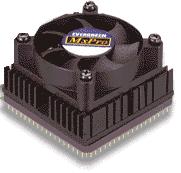
|
| Sockets |
5 - 7 |
| Pins |
320 |
| Speed |
233-400 |
| Fan |
Integrated |
| Core |
AMD K6-2 |
Example

|
| Slot |
1 |
| Pins |
NA |
| Speed |
400-1400 |
| Fan |
Integrated |
| Core |
Pentium III |
Example
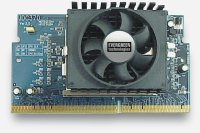
|
| Sockets |
PCI |
| Pins |
NA |
| Speeds |
333-466 |
| Fan |
Integrated |
| Core |
Celeron |
Example
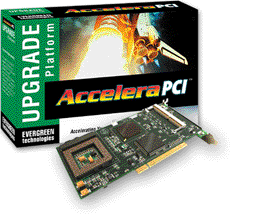
|
|
|
PNY has made products that are very similar to those
made by Evergreen.
Quickchip 133
One of the better known upgrade CPU's. It is based
on the AMD DX5-133. Basically just a high speed
486 with extra cache. It is a capable performer
and happens to be rather overclockable (160MHz
is usually attainable)
|
QuickChip 3D
the Quickchip 3D is based on the IDT Winchip2.
It has full MMX and 3DNow! support. Its graphics
erformance and FPU is lacking, but is good for
office applications.
|
| Sockets |
1 - 2 - 3 |
| Pins |
168 |
| Speeds |
133 |
| Fan? |
Integrated |
| Core |
AMD DX5 |
Example:
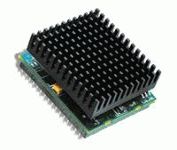
|
| Sockets |
5-7 |
| Pins |
320 |
| Speed |
180-266 |
| Fan? |
Integrated |
| Core |
Winchip C6 |
Example
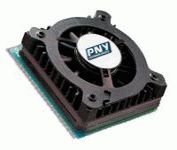
|
|
|
|
PowerLeap Products may be the king of upgrades. They
have upgrades for the 8086 all the way up to the Pentium
4. While some of their 'upgrades' fall more into the
SBC (Single Board Computer) category they are still
of interest
RENAISSANCE CPU Upgrades
PowerLeaps Renaissance upgrades are really independant
SBC's that happen to fit in an ISA slot, however,
we will still discuss them because having an old IBM
XT case and original motherboard, running Windows
XP is just too neat to pass up. Being as the ISA slot
in these is purely for mechanicle support, you could
mount these ANYWHERE, which opens the door to some
neat small profile applications, like perhaps a car.
PL-RENAISSANCE/AT
This adapter sits in an ISA slot and can run off
of most any XT or better power supply. It contains
a Super Socket 7 and 168pin DIMM slots running
the VIA MVP4 chipset. Sound, graphics, and USB
are built in.
|
PL-RENAISSANCE/370S
This adapter is along the same lines as the
R/AT, just with even more poer. It uses a Socket370,
giving you the ability to upgrade even your
IBM XT to Pentium-III (Tualitin) 1.4GHz speeds.
It uses the SiS 630E chipset which has graphics
and sound onboard. It even has Ethernet.
|
| Sockets |
ISA Slot |
| Pins |
NA |
| Speeds |
200-550 |
| Fan? |
Integrated |
| Core |
AMD K6 / K6-2 / K6-3 |
|
| Sockets |
ISA Slot |
| Pins |
NA |
| Speed |
800-1400MHz |
| Fan? |
Integrated |
| Core |
Pentium IIIS |
|
Socket Based CPU Upgrades
PowerLeap made no less then 8 different Socket based
CPU Upgrades.
PL/586-133
This is PowerLeaps version of the common Am5x86-P75
CPU clock quadrupled 486 with voltage regulators. |
PL-54C/MMX
The PowerLeap PL-54C is the first Upgrade chip
to use PL's IPS system. IPS (Independant Power
Source) uses a floppy power connector to power
the CPU, taking the strain off of the motherboards
regulators and allowing CPU's with higher power
requirements to be used in old motherboards.
This is merely a socket, it will allow you to
use any CPU up to 550MHz in an old system. |
PL-PROMMX
PLUS
This is the newest version of PowerLeap's Socket
5-7 Upgrade product. It has IPS and also supports
more voltages. It also supports 75 and 83MHz
bus CPU's. |
PL-PRO/II
The PRO/II is a Celeron based upgrade for Pentium
Pro systems. It supports PPGA Celerons up to
533MHz and FC-PGA Celerons up to 700MHz*, making
this the fastest upgrade for Pentium Pro's available.
It supports dual CPU's only when using PPGA
celerons (Intel disabled SMP on FC-PGA Celerons) |
| Sockets |
486 |
| Pins |
168 |
| Speeds |
120-133 |
| Fan? |
Integrated |
| Core |
Am5x86-P75 |
 |
| Sockets |
5 - 7 |
| Pins |
320 |
| Speeds |
166-450 |
| Fan? |
Integrated |
| Core |
Any x86 |

|
| Sockets |
5 - 7 |
| Pins |
320 |
| Speeds |
166-450 |
| Fan? |
Integrated |
| Core |
Any x86 |

|
| Sockets |
8 |
| Pins |
387 |
| Speeds |
300-700 |
| Fan? |
Integrated |
| Core |
Celeron |
 |
* With a Celeron running faster than 600MHz, you
must use the PL-Pro/II in
conjunction with the PowerLeap Neo S370.
PL-Neo S370
This is a cost-effective PPGA to FC-PGA CPU
upgrade adapter. With the Neo S370, you can
install an Intel Pentium III or Celeron "Coppermine"
CPU (in the
FC-PGA package) into a Socket 370 computer designed
for an earlier generation PPGA Celeron CPU.
|
PL-Neo/T
This is an economical upgrade solution that
allows systems based on Socket 370 Intel Pentium
III and Celeron FC-PGA (Coppermine) CPUs to
use FCPGA2 Pentium III/Celeron (Tualatin) CPU
technology. With this product, you can obtain
significantly faster performance (up to 1.4GHz)
from your Socket 370 systems.. |
PL-370SMP
This is a dual processor capable version of
the Neo. |
PL-P4/N
The P4/N allows users to upgrade the Socket
423 (which Intel used for only a short time)
to the newer Socket 478 CPU's. |
| Socket |
370 |
| Pins |
370 |
| Speeds |
533-1100MHz |
| Fan? |
Integrated |
| Core |
Coppermine |

|
| Socket |
370 |
| Pins |
370 |
| Speeds |
533-1400MHz |
| Fan? |
Integrated |
| Core |
CuMine or Tualatin |

|
| Socket |
370 |
| Pins |
370 |
| Speeds |
533-1400MHz |
| Fan? |
Integrated |
| Core |
Tualatin |

|
| Socket |
423 |
| Pins |
423 |
| Speeds |
1.8-2.8GHz |
| Fan? |
Integrated |
| Core |
Northwood |

|
PL-K6-III
This upgrade is designed specifically to upgrade
Socket 5-7 systems to the K6-III CPU. The K6-3
is the fastest CPU available for Socket 7. |
PL-AXP
The AXP allows you to use a new (Thouroughbred
or Barton) cored AMD CPU in an older system,
that normally would only support up to a 1400MHz
thunderbird. This is the only such adapter that
exists. |
| Socket |
5-7 |
| Pins |
370 |
| Speeds |
333-600 |
| Fan? |
Integrated |
| Core |
K6-3 |

|
| Socket |
A |
| Pins |
462 |
| Speeds |
1400-2800 |
| Fan? |
Integrated |
| Core |
Tbred/Barton |

|
PowerLeap Slot Based CPU Upgrades.
PL-PII
This is one of the first 'Slocket's with a
few more options, it supports voltages from
1.8V all th way to 3.5V (more then you will
ever need) and supports BSEL 66, 75, 83, 95,
100, and 133. |
PL-iP3 Rev. 2
Another slocket from Powerleap, this one has
voltages from 1.3V - 3.5V and is SMP compliant
(the first revision wasn't) It also has an LED
on it and a fan connector. One of the best Slockets
around. It also has owerleap's PS (Independant
Power Source) |
PL-P3SMP
About the same as the iP3 but is meant for
servers, it has self repairing fuses to help
orotect the CPU and motherboard. It supports
Cu and Tualatin CPU's |
PL-P3/Xeon-s
The same as the P3SMP but designed for Slot
2 systems. It is built to higher standards then
the normal Powerleap adapters. |
| Socket |
Slot 1 |
| Pins |
242 |
| Speeds |
300-533 |
| Fan? |
Integrated |
| Core |
PPGA Celeron |

|
| Socket |
Slot 1 |
| Pins |
242 |
| Speeds |
300-1400MHz |
| Fan? |
Integrated |
| Core |
Any Socket 370 |

|
| Socket |
Slot 1 |
| Pins |
242 |
| Speeds |
533-1400MHz |
| Fan? |
Integrated |
| Core |
Cu or Tualatin |

|
| Socket |
Slot 2 |
| Pins |
NA |
| Speeds |
533-1400MHz |
| Fan? |
Integrated |
| Core |
Cu or Tualatin |

|
|
|
|
Upgradeware Technologies is a relatively new player in
the upgrade business. They are a Taiwan based company that
was founded in 2002.
Slot-T
SLOT-T allows the new Tualatin-core CPUs to be used
on those motherboards which only support Intel Slot
1 and can be upgraded to Coppermine/Tualatin-core
CPUs at speed of 533aMHz upto 1.4GHz. It supports
voltages from 1.3V and up and is SMP compatible. |
370GU
370GU allows the new Tualatin-core CPUs to be used
on those motherboards which only support Intel FC-PGA
Pentium III (500~1.1G) / Celeron (533A-1.1G) and can
be upgraded to Tualatin-core CPUs at speed of 1.0GHz
upto 1.4GHz.
|
p478
p478 allows PGA423 Pentium 4 (1.3G~2.0G) systems
to take advantage of 0.18 micron Intel mPGA478 Pentium
4 processors based on Willamette and 0.13 micron Pentium
4/Celeron Northwood processors in order to reach speeds
exceeding 2.8GHz.
|
XP-TMC
This adapter allows the use of the newer Thouroughbred,
Applebred, Thorton, and Barton CPU's in older Socket
A boards. It has very good multiplier control. It
does not support Palominoe or Sempron CPU's |
| Socket |
Slot 1 |
| Pins |
242 |
| Speeds |
300-1400MHz |
| Fan? |
Integrated |
| Core |
Cu or Tualatin |

|
| Socket |
370 |
| Pins |
370 |
| Speeds |
1000-1400MHz |
| Fan? |
Integrated |
| Core |
Tualatin |

|
| Socket |
423 |
| Pins |
423 |
| Speeds |
1.8-2.8GHz |
| Fan? |
Integrated |
| Core |
Northwood |

|
| Socket |
A |
| Pins |
462 |
| Speeds |
1400-2800MHz |
| Fan? |
Integrated |
| Core |
Athon XP/MP |

|
|
Gainbery Computer
Products 
Gainbery (a company that was based in Ontario, Canada)
based its upgrade chips on the Cyrix 5x86 and 6x86 series
of CPU's as well as Pentium based ones.Gainbery was established
in 1988. Gainbery went out of business sometime after March
of 1997.
MAXimizer GB586-133NB
This is a rare upgrade indeed, it was designed using
a QFP Cyrix 5x86 and is specifically designed to upgrade
notebooks. It is low power and only draws 1.5Amps.
It has a 5V supply for the fan, but the CPU runs on
3.45V. The heatsink is standard (the one without is
from a product brief)
Interesting Note: The press releases say AMD 5x86,
so I am unsure what actually hit the market.
Suggested retail was: $199 |
Maximizer GB586-75
Maximizer GB586-120
Maximizer GB586-133
These upgrades are based on the Cyrix/IBM 5x86 chip.
The 133 uses a Cyrix 5x86 in a QFP package, whereas
the 120 uses a IBM 100MHz part (overclocked no less).
The 5x86 is based on the 6x86 so the performance is
quite good.
The 75, 100 amd 120MHz version are Cyrix, while the
133 is an AMD..
Suggested retail was: $139 |
| Socket |
486 |
| Pins |
168 |
| Speeds |
75-133 |
| Fan? |
Integrated |
| Core |
5x86 |
|
| Socket |
486 |
| Pins |
168 |
| Speeds |
75-133 |
| Fan? |
Integrated |
| Core |
Cyrix 5x86 |
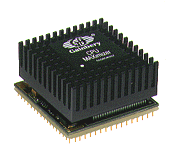
|
Gainbery Pentium Class Upgrades
CPU MAXimizer 686i 100-166
CPU MAXimizer 686G 100-166
The CPU MAXimizer 686 upgrade series, an integrated
upgrade CPU module to replace the P5-60/66 processor.
Based on a Cyrix/IBM 6X86 processor, Gainbery has
provided a voltage-conversion circuit, together with
pin-alignment convertor, which allows P5-60/66 users
to double their system power. It seems that later
versions of this Upgrade used a pentium CPU. Details
are sketchy as Gainbery no longer exists
Suggested retail was: $349-$899
|
MAXimizer P60 - P100 Booster
These upgrades used Intel CPU's to upgrade older
Pentium Socket 4 and 5 systems too what Gainbery called
'Intel Overdrive' Performance.
Suggested retail was: $289-$499 |
MAXimizer Booster 200/180A & 200/180B
Version A is a 200MHz Pentium upgrade for Socket
5, while version B is the same for Socket 4. This
would make the Booster 200 the fastest upgrade ever
made for the Pentium 60/66
Suggested retail was: $1099 |
| Socket |
4 |
| Pins |
273 |
| Speeds |
100-166MHz |
| Fan? |
Integrated |
| Core |
Cyrix 6x86 or P55 |
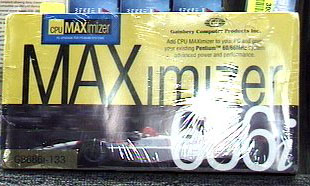
|
| Socket |
4 & 5 |
| Pins |
273 & 296 |
| Speeds |
125-166MHz |
| Fan? |
Integrated |
| Core |
P54C |
|
| Socket |
4 & 5 |
| Pins |
273 & 296 |
| Speeds |
180-200MHz |
| Fan? |
Integrated |
| Core |
P54C |

|
|
Return to Top
|















